[rough skinned newt overview]
 :: Latin Name
:: Latin Name
Taricha granulosa
:: Common Name(s)
Rough-skinned Newt; Oregon Newt; Western Orange-belly Newt
:: Description
Males of this species are generally larger, reaching 7-8" in total length (about 4" SVL) with females generally about 5-6" in total length (3" SVL). During the breeding season, males will take on distinct morphological characteristics including smooth skin, lighter coloration (often darker along their sides), thickened tail, swollen cloaca, and rough black nuptial pads on their feet.
:: Captive Life
In captivity, Taricha granulosa can be expected to live 15+ years. With proper care, this is a hardy species that is relatively easy to care for. Since food is generally easy to come by (earthworms are sold at bait shops or can be caught outdoors) the most important considerations for care are water quality and temperature. T. granulosa cannot withstand prolonged temperatures above 80 degrees F, so a method of cooling them is necessary in warm climates. A water filtration system and/or consistent partial water changes is also necessary to maintain proper water quality and prevent health problems.
:: Similar species
T. granulosa is very similar to Taricha torosa (California Newt). The definitive way of differentiating the two species is the vomerine teeth pattern ("V" shaped in granulosa, "Y" shaped in torosa), but this this is not practical unless the newt is already deceased. Other differences between the species are lower eyelid coloration (dark in granulosa, lighter in torosa), position of the eyes when viewed from above (protrudes past the edge of the head in torosa), and eye size (smaller in torosa). In terms of behavior, granulosa tends to be more aquatic than torosa.
[rough skinned newt care]
 enclosure
enclosure
One adult T. granulosa requires a minimum 10 gallon tank (+5 for each additional newt). Bigger tanks are much more desirable, make health issues less likely, and will help enrich the life of the animal.
Since these newts are semi-aquatic, you will need to provide approximately equal parts land and water. In order to maximize usable area (especially in smaller tanks) try to create "land" area that rests securely just above the water. The water depth can vary (slope the gravel/rocks), with 3-12" (8-30 cm) working well. Aquatic plants, terrestrial live plants and moss are ideal for this species, providing hiding places and also benefiting the water quality (filter out waste products).
Tankmates
Because of the toxicity of this species (along with other reasons) it is extremely unwise to place different species of newts or other herps into the same enclosure. If you are housing more than one rough-skinned newt in the same enclosure, you will also want to make sure they are close to the same size.
lighting & temperature
These newts like cool temperatures, but also do fine at room temperatures of 60-70°F (18-21°C). Temperatures should not be allowed to exceed 80°F. If you live in a warm climate and do not have air conditioning, consider purchasing an aquarium chiller, move the enclosure to a basement or cooler location, or take other measures to cool the enclosure (place frozen water bottles in the tank periodically, etc.). However, any changes in temperatures should be made gradually.
Lighting may be necessary if you have a setup with live plants, however, you will need to make sure that the light is not raising the temperature of the enclosure to unsafe levels. Fluorescent bulbs are generally best since they do not put out much heat.
water
Since this species is semi-aquatic and spend quite a bit of time in the water, water quality is extremely important. Tap water should ideally be filtered and treated with water conditioners such as AmQel and NovAqua (made by Kordon) to remove chlorine, chloramines, ammonia and toxic metals. A water filtration system is a good idea, but you can also do partial water changes every 1-2 weeks. Be sure not to put any questionable items (decor, etc) into the enclosure that could leach harmful chemicals into the water.
food
FOOD: Earthworms are the ideal food for newts. They can be purchased online, at bait shops, or collected from a safe location outdoors (far away from pesticides, fertilizers and human activity in general). Worms that are too large can be chopped into smaller pieces and offered to the newts. Waxworms are another feeder option. They are very nutritious, but high in fat, so they should not be fed to overweight newts. Blackworms are another very nutritious option. They are often available at pet shops that specialize in fish. These worms are very small however, so they are difficult for larger newts to grasp. I feed blackworms to my adult newts by picking up a blob of worms and placing them on a spoon or shallow dish. Take the newt out of the enclosure (otherwise blackworms will get everywhere). If your newt is tame (not alarmed), they will bite into the blob, grabbing a mouthful of worms ... looks kinda like a kid eating spaghetti. Bloodworms are also quite nutritious, but live ones are hard to find ... many captive newts learn to eat frozen bloodworms (available at many pet stores). Small gutloaded crickets, small feeder roaches and sowbugs can also be offered. Slugs, gross as they are, are also a possible food item, however, make absolutely sure they are collected from areas where pesticides & fertilizers might have been used. Mealworms are not very nutritious, but are commonly available and can be offered (it's best to squish their heads a little so they can't bite your newt). Other possibilities include tubifex and other types of worms, an occasional small fish (not "feeder" goldfish), ghost shrimp, freeze dried krill, large brine shrimp, small snails, leeches, tadpoles, other insects and pellet foods.
FEEDING SCHEDULE: Adult newts will need to eat about 1-2 times per week. Be careful not to overfeed (if your newt starts to look fat, cut back a little). Do not leave excess food in the tank (crickets are known to stress animals when left in the enclosure, and other food items often drown/die and pollute the newt's environment.
[rough skinned newt breeding information]
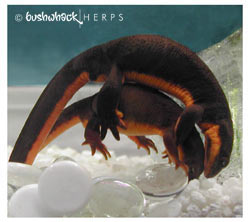 Taricha granulosa breed during the spring months. In the low elevations (down to sea level, like where I live) they breed earlier than in the higher elevations. Their peak months around Seaside are March & April, but can begin as early as February depending on the year. Breeding lasts several months, and they are easy to spot in the ponds where they congregate. It is not unusual to find them massed together in a little "newt orgy" ball.
Taricha granulosa breed during the spring months. In the low elevations (down to sea level, like where I live) they breed earlier than in the higher elevations. Their peak months around Seaside are March & April, but can begin as early as February depending on the year. Breeding lasts several months, and they are easy to spot in the ponds where they congregate. It is not unusual to find them massed together in a little "newt orgy" ball.
Males change in appearance during breeding season. They become smoother (almost slippery), their tails become fatter (viewed from the side, they are much thicker than normal), 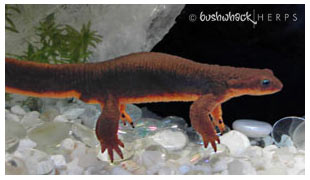 and they will get black nuptial pads on the tips of their toes. I've also noticed that the males seem to become lighter in coloration, with darker sides and their forearms seem to flatten out and enlarge (they kinda look Popeye-ish to me). These physical changes, with the tendency for males to be larger than the females, make it easy to distinguish the sexes.
and they will get black nuptial pads on the tips of their toes. I've also noticed that the males seem to become lighter in coloration, with darker sides and their forearms seem to flatten out and enlarge (they kinda look Popeye-ish to me). These physical changes, with the tendency for males to be larger than the females, make it easy to distinguish the sexes.
*The first picture on this page shows a pair in amplexus, but it was early in the season and the male was not yet in full breeding mode. The picture above shows the same male in full breeding attire (notice the fatter tail, lighter color, and nuptial pads on the tips of his toes).
 Because this species breeds locally, I can take advantage of the natural conditions (temperature, light cycle, etc) to stimulate my captive newts to breed. I keep my newts in an outdoor enclosure for most of the year. That way they get a cooling period and a change in day length. I find that my newts start to get in the "mood" at about the same time as the local populations.
Because this species breeds locally, I can take advantage of the natural conditions (temperature, light cycle, etc) to stimulate my captive newts to breed. I keep my newts in an outdoor enclosure for most of the year. That way they get a cooling period and a change in day length. I find that my newts start to get in the "mood" at about the same time as the local populations.
[baby rough skinned newt care]
Raising Young Tarichas
Before you attempt to raise newt larvae, you must realize that the process is extremely labor intensive. Water changes will probably need to be done daily, if not a couple times a day. You will also probably have to culture microfoods for them ... whether that be brine shrimp, daphnia, worms or something else, and feed the larvae every day.
caring for taricha larvae & eggs
T. granulosa lay eggs singly, attaching them to aquatic plants and other objects. The eggs are about 1/8" in diameter and have a clear jelly coating. The egg itself is half cream, half brown when it is first laid (brown side usually faces up). As the embryo develops it will take on a crescent shape, as it develops into a larvae. Sorry, I forgot to take pics of the eggs ... I'll take some next breeding season.
If you are breeding captive newts, you will need to remove the eggs from the adult tank, otherwise they will get eaten. Eggs are laid over a period of several months, so you will need to check often. The eggs and larvae can be kept in a tank or shallow, open container. If you keep them in deeper water, you should aerate the water with gentle/small bubbles from an air pump & airstone. Remove any bad moldy-looking eggs immediately, and do a partial water change daily if you are using a small container.
 When the larvae emerge they look something like the one pictured on the right. They are are brownish in color with some speckling, and frilled gills. At this age they can eat microscopic pond invertebrates (such as daphnia) or newly hatched brine shrimp, but may not eat for the first day or so after hatching as they absorb the yolk. Food can be provided by adding fresh water from a healthy pond daily, or you can hatch your own brine shrimp (see hatchery instructions). You can easily see the larvae feeding ... they lurch forward a little as they suck in their food. If you use brine shrimp, you will need to rinse the salt water off of them before feeding them to the larvae. They will last a couple hours in fresh water before they die, so you will need to siphon the dead ones out with a turkey baster, or do a water change to avoid polluting the water. Other food options are small worms such as microworms or white worms.
When the larvae emerge they look something like the one pictured on the right. They are are brownish in color with some speckling, and frilled gills. At this age they can eat microscopic pond invertebrates (such as daphnia) or newly hatched brine shrimp, but may not eat for the first day or so after hatching as they absorb the yolk. Food can be provided by adding fresh water from a healthy pond daily, or you can hatch your own brine shrimp (see hatchery instructions). You can easily see the larvae feeding ... they lurch forward a little as they suck in their food. If you use brine shrimp, you will need to rinse the salt water off of them before feeding them to the larvae. They will last a couple hours in fresh water before they die, so you will need to siphon the dead ones out with a turkey baster, or do a water change to avoid polluting the water. Other food options are small worms such as microworms or white worms.
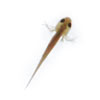 Soon the larvae will get their front legs and look something like the one on the right. If you see any obvious deformities, mutations or weak larvae you will need to cull these animals. A larvae that spins around in circles ("spinners") should be culled (they die anyway if you don't euthanize them). Overpopulation will impact water quality and food availability for the entire batch, so it is best to give away some of the young to someone else interested in raising them, or euthanize them.
Soon the larvae will get their front legs and look something like the one on the right. If you see any obvious deformities, mutations or weak larvae you will need to cull these animals. A larvae that spins around in circles ("spinners") should be culled (they die anyway if you don't euthanize them). Overpopulation will impact water quality and food availability for the entire batch, so it is best to give away some of the young to someone else interested in raising them, or euthanize them.
 After they get their front legs, little stubs will appear and form the back legs. As more larvae hatch and grow, you may need to move them to larger (or multiple) containers and do more frequent water changes. Bare-bottom plastic shoe boxes & tubs work well ... they are easy to clean and inexpensive. A small aquatic plant or a few pebbles provide plenty of hiding places, and still make it easy to keep track of the babies.
After they get their front legs, little stubs will appear and form the back legs. As more larvae hatch and grow, you may need to move them to larger (or multiple) containers and do more frequent water changes. Bare-bottom plastic shoe boxes & tubs work well ... they are easy to clean and inexpensive. A small aquatic plant or a few pebbles provide plenty of hiding places, and still make it easy to keep track of the babies.

Above picture: You will be able to see how well your larvae are eating if you are feeding them newly hatched brine shrimp ... their bellies turn bright orange.
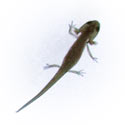 As they grow, the larvae become less transparent, and more of a dark brown ... they start to look more like real newts. Their tails also become flatter (rounder and less fishy). Their head shape takes on an appearance more like the adult newt, their gills get shorter, and they begin to get the 2 tone adult coloration (brown w/ orange belly). At this stage they are big enough to eat chopped blackworms, in addition to the smaller foods.
As they grow, the larvae become less transparent, and more of a dark brown ... they start to look more like real newts. Their tails also become flatter (rounder and less fishy). Their head shape takes on an appearance more like the adult newt, their gills get shorter, and they begin to get the 2 tone adult coloration (brown w/ orange belly). At this stage they are big enough to eat chopped blackworms, in addition to the smaller foods.

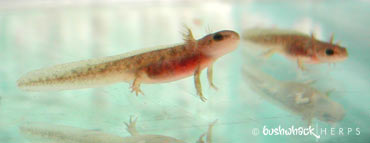
The pictures below show the larvae becoming even darker, less transparent, with flatter tails.
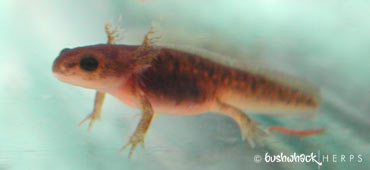

When the larvae start to look like the picture below, metamorphosis is fast approaching. Notice how the transparent areas of the tail are nearly gone, and the gills have shortened. The 2 tone coloration is more distinct, and the features are similar to adult granulosa.


The larvae at this stage can be feeding primarily on chopped blackworms, bloodworms, tubifex worms and other small aquatic worms. You will now need to prepare a metamorphosis setup ...
caring for taricha morphs
 As your larvae become darker in coloration, with rounder tails and shortened gills, it is time to prepare for metamorphosis. You may even see the larvae gulping for air at the surface. You need to provide a land area for the morphs to climb onto. This can be done by providing a shallow water area with an island, sloping gravel, or by tilting the container slightly so that one end is dry.
As your larvae become darker in coloration, with rounder tails and shortened gills, it is time to prepare for metamorphosis. You may even see the larvae gulping for air at the surface. You need to provide a land area for the morphs to climb onto. This can be done by providing a shallow water area with an island, sloping gravel, or by tilting the container slightly so that one end is dry.
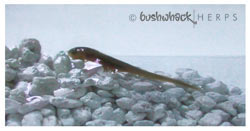 The most important thing the morphs will need is a LID! Morphs are excellent climbers, and without an escape-proof enclosure, can climb out of the container and become lost in your home.
The most important thing the morphs will need is a LID! Morphs are excellent climbers, and without an escape-proof enclosure, can climb out of the container and become lost in your home.
*This picture shows my first CB baby taking its very first breaths of air! I saw it start to go towards the land and watched for some time before it slowly stuck its head out of the water ... I didn't think I'd actually be able to photograph "the moment!"
 During metamorphosis it is common for baby newts to stop eating for a few days. Once they have morphed, baby newts will generally be terrestrial and will not need a large water area. You can move morphs to an enclosure of moss or other substrate, with a small water dish. Morphs can continue to feed on whole or chopped blackworms. You may be able to offer food using tweezers, or you can place the worms on a moist paper towel.
During metamorphosis it is common for baby newts to stop eating for a few days. Once they have morphed, baby newts will generally be terrestrial and will not need a large water area. You can move morphs to an enclosure of moss or other substrate, with a small water dish. Morphs can continue to feed on whole or chopped blackworms. You may be able to offer food using tweezers, or you can place the worms on a moist paper towel.
Try to feed a variety of insects to your growing morphs. Earthworms are one of the most nutritious foods for newts, and if you create your own "worm bucket" you can raise tiny earthworms to feed to your baby newts. Small crickets, sowbugs, fruit flies, and other insects can also be offered.

